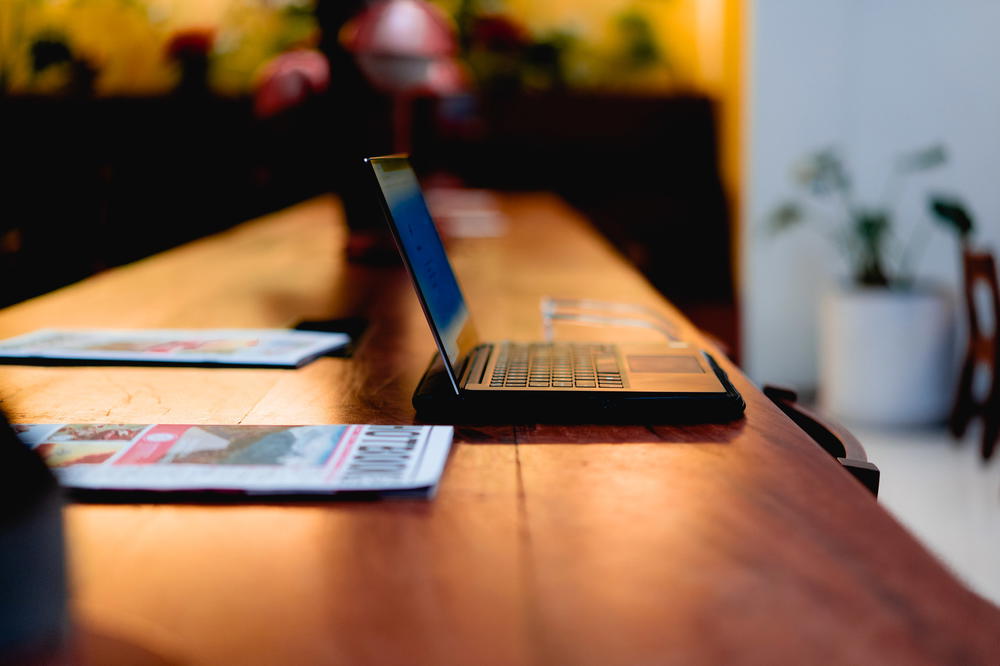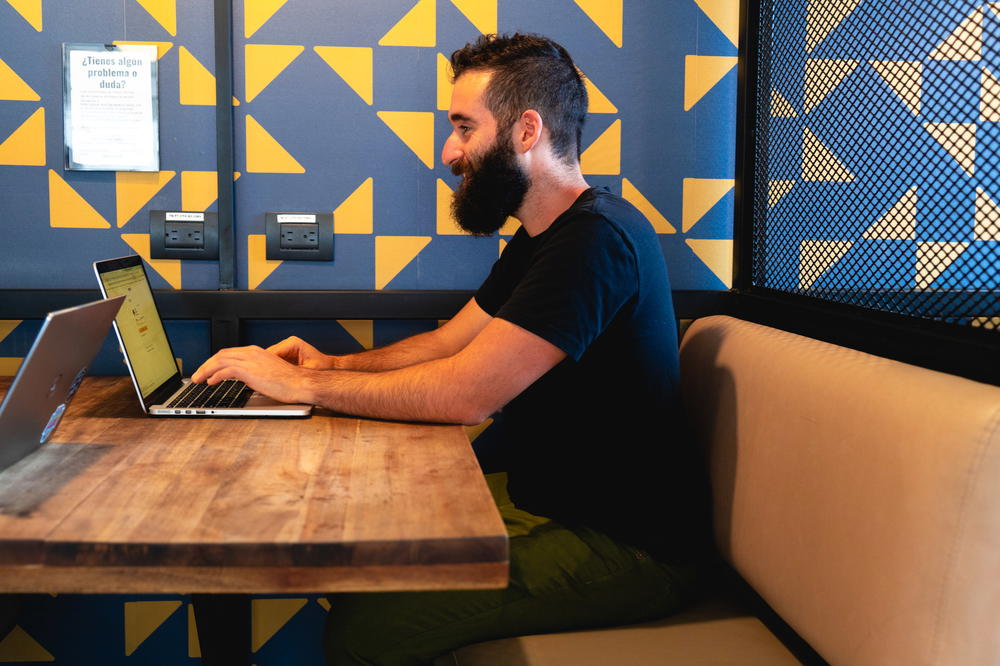How to Balance Freelance Work While Working Full-Time (17 Tips)

Can you freelance while working full-time? Yes! Here are our best tips for how to manage freelancing with a full-time job and how to balance your 9-to-5 with additional freelance clients.
This article may contain affiliate links. We earn a small commission when you purchase via those links — at no extra cost to you. It's only us (Becca & Dan) working on this website, so we value your support! Read our privacy policy and learn more about us.
Table of contents
- Identify what you do outside of work that is important to you
- Prioritize your full-time work first
- Understand the overhead with freelancing
- Try partnering with another freelancer to help with your freelance business
- Consider working with clients in different time zones
- Perfect your time estimates
- Set clear client expectations when freelancing
- Be transparent about your time and availability when freelancing
- Think through your final freelance project launch date
- It’s ok to say no (as a freelancer working full-time elsewhere)
- Avoid burnout while freelancing and working full-time
- Make sure it’s worth it for you
- Work in a time-efficient manner as you freelance
- Track your time when you are freelancing
- Make sure it’s legal
- Use two computers
- Is it possible to work freelance while also working full-time?
Working full-time and working as a freelancer at the same time can start to take a toll on your free time and mental energy. There is a happy medium where you can do both.
In this article, I’m going to share some of my favorite tips on how you can balance working on freelance projects while working at your full-time job.
You may be in a position in which you don’t have a lot of obligations. You might be finding yourself with more and more time. So you’re thinking, “Huh, I could probably be freelancing.”
We’ve all been here at some point and time.
If you have freelance experience or if you are planning how you can pull it off, read some of these tips below to help you with your research.
Everyone has a different type of job and a different set of hours. I’ll try to give a few examples of scenarios that I’ve seen in the past and a few examples of what has worked for me.
Did you know that freelancing and/or having a side hustle gig are trending as some of the most popular work trends right now? There has never been a better time to offer a specialized service, especially when you have a flexible schedule and are ready for more commitments.

Identify what you do outside of work that is important to you
Because you’ll be picking up work in your free time, you’ll probably have to let something go. If you sit and home and watch six hours of TV a night, then I’m sure you can take some of that time and not feel guilty about it. You can start making some extra money, and be learning new professional skills at the same time.
If you have hobbies that you truly enjoy, try and leave time for those, as working too much can lead to a burnout, and you definitely want to know how to avoid burnout.
In some cases, you work to enable some of your hobbies. If all you do is work, then there’s nothing left!
Big tips here: If you came from freelancing as your full-time commitment and you’ve taken on a full-time job for a company, consider keeping some freelance clients you really like and enjoy working with. Our best tips for keeping freelance clients while working full-time can help a lot (see #7 in the list).

Prioritize your full-time work first
I can’t stress this enough. While you are currently working full-time, give all of your attention to your full-time job on normal working hours.
Don’t take freelance meetings during the work day, don’t write freelance emails while you are working and don’t take PTO in order to finish a freelance job.
If you’re in a situation in which you are able to start working freelance “full-time,” check out our guide on how to transition from working full-time to freelance.
While you’re currently employed full-time, giving all of your attention to your full-time job is professional and appropriate. If someone was working for you or for your company, you’d expect the same from them!

Understand the overhead with freelancing
If you’ve worked as a freelancer before, you know that working a freelance job can take a lot of overhead. When you’re onboarding a new client, there may be a lot of meetings and a lot of communication.
That communication can take a lot of time, especially with asynchronous communication, and can especially take time away from your available hours.
Try to plan for this overhead (in both time and resources) by working with “repeat clients” as much as you can. You can also develop strategies for streamlining some client onboarding, like creating documents and other training materials.

Try partnering with another freelancer to help with your freelance business
Because working as a freelancer comes with a lot of admin overhead, you’re often left with little time to do the actual work. Partnering with another qualified freelancer is a great way to split the responsibilities.
This is something that I do from time to time. I work with a client with a business partner, who is another freelancer I trust. I focus on web development, and my business partner focuses on communicating with the client, drafting proposals and delivering the work.
This allows the client to conduct business on normal business hours, and allows me to work on the website whenever I get a spare minute. Usually, this is nights and weekends. I set myself up for this, so it fits into my schedule and I expect it.
Do you need a website as a freelancer? Read our guide to learn more!
Consider working with clients in different time zones
Time zones are a tricky thing when you work remotely. In fact, check out our article on working with different time zones like a pro! You can use them to your benefit if you pick a client that is a few hours away from your home time zone. In fact, we recommend a handy tool called Worldtimebuddy that you can read about in our list of helpful websites for virtual remote work.
The way this works is such that your morning may be the client’s late afternoon. You can hold all of your meetings in the early morning in order to not conflict with your normal working hours, and not make your client work weird hours as well.
Sometimes it may not work out in your benefit. I was once working with a client in Australia, while I was working remotely abroad in Vietnam, and coordinating with a project manager in Florida.
I planned for a meeting at a time when it would be 4 a.m. for me, and normal business hours for everyone else. I inconvenienced myself in order to hold a meeting at a reasonable time for everyone else. This is the potential drawback here.
In the end, it worked out, and luckily, I woke up for my 3:45 a.m. alarm.

Perfect your time estimates
Your time is very valuable, especially when you have a limited amount of it. When you are scoping your projects, learn how to create estimates that make sense for your schedule, especially when you’re working from home.
Let’s say that someone is hiring you for a social media manager freelance position. They are asking you to be able to post 10 Instagram in-feed posts, create 10 Pinterest Pins and draft 10 Facebook posts.
Time yourself making one or two of the posts, first. Then, calculate how much time it will take you to do the rest, using that benchmark estimate. To play it safe, add more time! It’s better to overestimate in order to deliver to your client faster and impress them.
The more and more you work with a specific type of freelance-style project, the better you’ll get with estimating your own time.

Set clear client expectations when freelancing
You want to be clear and concise with your freelance project deliverables. Your client is hiring you to do work, and trusting that you’ll deliver the best work possible.
Be over-communicative about what the client wants, and have regular check-ins if the project spans a few weeks and months. You want to make sure that you’re going in the right direction and the work that you’re currently doing aligns with what the client expects.
You don’t have the time to have to re-do work. Plus, that will start to be expensive if you need to handle multiple revisions.
Either way, having clear client expectations is a good business practice that you can exercise while you’re working as a freelancer.
Be transparent about your time and availability when freelancing
This might sound like a bold statement, but let your client know that you have a full-time obligation. This doesn’t have to come off as ”I have a full-time job.” For all the client knows, you’re not available during regular business hours, and that’s that.
Setting this expectation up front sets the stage for a client. It’ll avoid that client expecting to hear from you during normal business hours, which is a response time you’re likely not available to offer.
This has come up with a lot of my clients, and they have all very been understanding. The client chose to work with you. Setting the terms is a small piece of the puzzle to start a meaningful client-freelancer collaboration.
Be kind to yourself and be cognizant about your work-life balance as a freelancer. The tips we list are crucial to have in mind as you work and set aside time for yourself to decompress and relax in the ways you like to, so that you have energy to stay on task and make deadlines.

Think through your final freelance project launch date
Try and set a final deliverable on a Monday morning with a final review for Thursday night (for example). This gives a client their Friday to review, and to provide feedback that you’re able to tackle over the weekend.
Alternatively, you can set hard deadlines and guidelines for when feedback is received and when feedback is incorporated.
What you’re trying to avoid is setting a complete date (a deadline) midweek, but then also have to stay up all night to incorporate last-minute feedback that you received. Remember, these are all things you’re committing to while still working full-time.
It’s ok to say no (as a freelancer working full-time elsewhere)
Sometimes projects don’t work out. Even if the perfect freelance project comes your way, it’s okay to say no, if you are unable to fit it into your schedule.
You can also say yes, but postpone the work for a few months if the client is okay with the new deadline.
If you have a network of freelancers, you can try and pass the project to someone else who you know. Creating this system of referrals may come back to you if someone else is over capacity and needs your help with future projects.
We recommend always continually networking, which is even possible when working remotely. The more freelancers with similar skill sets you know, the better. Plus, someone may offer you a job they can’t take, when you happen to have downtime between freelance projects.
Because you’re a busy person, you don’t want to stretch yourself too thin and produce low-quality work. You want to produce great work, because that can lead to future work!

Avoid burnout while freelancing and working full-time
Be conscious of how much time you spend working and take time for yourself if you need it. Take a weekend off and relax. Sleep in if you can!
We wrote an article on how to prevent burnout, to help you come up with some ways that work for you in terms of avoiding burnout as a freelancer or professional balancing multiple obligations.
We recommend things like not working on weekends! Working weekends can be critical to your freelance side business. If that’s the case, maybe don’t work every weekend.
Make sure that you get up, walk around, exercise and spend time with the things that you enjoy doing. By this, we mean to make sure you balance health, well-being and physical fitness in order to get some time that is not glued to a screen.
Freelancing while working full-time does not mean you have to quit your full-time job, but if it’s the right more for you, then it’s the way to go.

Make sure it’s worth it for you
You sacrifice a lot of your free time in order to freelance. Is it worth it? Why are you doing it in the first place?
For me, I freelance on the side because I am trying to save as much money as I can in my younger years. I understand the power of compound interest and I try to put as much away as I can, so that it’s worth more later.
By freelancing on the side (and working this website) I sacrifice a lot of free time that I could be using to do other things. Personally, I like learning new things and exploring new topics, so this leads me to freelancing
Freelancing enables me to do that, so I am okay with spending less time watching TV and more time helping people where I can, in order to further and elevate their businesses.
Work in a time-efficient manner as you freelance
One thing that helps me focus and not get distracted is to close browser tabs that are not necessary. I like to clean up my Desktop and Downloads folders, so I don’t get distracted or reminded of other work on my laptop.
As you’re working, it can help to block out distractions, which helps you focus as much as you can on the task at hand.
Basically, check out our ways to be productive when you work from home, which mostly apply to freelancing, wherever you are!
Try setting small goals for yourself. When I run, sometimes I try sprinting to the next light post. That’s a small goal. When you’re working and if you have a few emails to go through, set your mind to finishing out those emails.

Track your time when you are freelancing
Tracking your time is a great way to learn how long things take you. It can also help pull you out of a rabbit hole that you’re digging deeper for yourself.
The benefits of tracking your time can also be attached to your invoicing and make it easy to round up the tasks that you accomplished and how long it took you.
The more and more you track your time, the easier it will become for you to create accurate estimates.
Tracking your time can also be a great way to set a limit on something specific. I once read an article about someone who only had 1 hour of free time each day. In the article, she decided to write 1 blog post. After the hour, no matter what the condition the article was in, she’d hit publish.
This taught her to get something accomplished in the set amount of time. It also proved that you can make follow up revisions. Not everything has to be perfect, but it’s important to know how to get to that level of perfection.
Make sure it’s legal
Look through your contracts and make sure that you don’t have any non-competes in your full-time agreement or in any potential freelance contracts that you accept.
I’ve seen some full-time contracts state that freelancing is not allowed. If this is the case, ask your HR department if they can clarify the statement and if your situation is okay.
Usually, this rule is instituted because employees might have been “double-dipping” and freelancing while they were working full-time. If you can demonstrate that you’re still getting your job done, HR may allow it.
Remember that if your freelancing gets so huge that you might want to gravitate away from your full-time job, see our guide to turning your freelancing into a full-time job.

Use two computers
If you don’t have a personal computer, I’d consider getting a new one for your freelance business. Your company laptop might actually own the intellectual property performed on it. This would be a big deal if your freelance client and your full-time client were ever in a dispute because of you!
We talk about our laptops and all our home office accessories in this article about how to set up a home office. Depending on whether you are a “Mac Person” or a “PC Person,” we have suggestions for both.
I use two computers and it helps separate my concerns about what I’m working on. It also allows me to sync different browser profiles to have different bookmarks, password manager settings and different levels of security.
We recommend that everyone gets a password manager like 1Password. To see if a service for password management like a password vault is right for you, check out our additional information about it under our useful apps for working remotely.

Is it possible to work freelance while also working full-time?
Ultimately, it’s up to you. It depends which kinds of commitments your clients require, but many people take on freelancing in addition to their full-time jobs, whether they’re talking loudly about it or not.
Freelancing outside of your full-time job can be a great way to bring in extra cash each month and work toward savings goals, and also a great way to keep connections you’ve made in the past by freelancing previously.
If you are looking for a place to keep your savings, check out Wealthfront. It’s what we use and the APY is too good to pass up. Check it out!
Lastly, freelancing can be a great way to keep working on professional skills you may not employ at your full-time job, and your freelancing may also provide you with more fulfillment and reward than your full-time work.
We hope you can make freelancing while working full-time work to the fullest!
💼 Growing your freelance career?
These freelancing playbooks come straight from our wins and misses. If our advice unlocked a new client or idea, a coffee helps us share more real stories.
Support our freelance resourcesYou may also like
-
![A laptop computer on a table with a cup of coffee.]()
14 Pros and Cons of Freelancing Vs. Working Full-Time
What are the pros and cons of freelancing? Are there advantages and disadvantages of freelancing? See the benefits of freelancing, and differences between being freelance vs. an employee.
-
![A black office chair in front of a window.]()
How to Take Time off as a Freelancer
Can you take vacation time as a freelancer? Here’s the best way to take time off from your freelance business, in this guide to taking a break from work when you’re self-employed.
-
![A woman working at a desk in a small room.]()
How Many Hours Is Considered Part-time? Is Full-time Better?
What are the pros and cons of working part-time, and what are the benefits of working part-time vs. full-time? Find out here, as we discuss if employers prefer full-time or part-time employees.
-
![Minimalist home office setup of black headphones, an apple magic keyboard, silver MacBook Pro on a laptop stand and cup of tea]()
How to List Your Freelance Experience on Your Resume
How do you prove your freelance work experience on a resume? Here’s how to create a freelance business resume with tips for making freelance skills stand out and shine.
-
![a wooden table with a laptop on it]()
How (And When) to Fire a Freelance Client
What’s the best most proven way to fire a freelance client? Use these examples with our “How to fire a client” sample letter and email template script.
-
![A man sitting at a table with a laptop.]()
How to Transition from Full-time to Freelance (17 Actionable Tips)
Looking for how to transition from working full-time to freelancing? See our best 17 tips for how to start freelancing from scratch, secure freelance clients and when to go full-time freelance.







